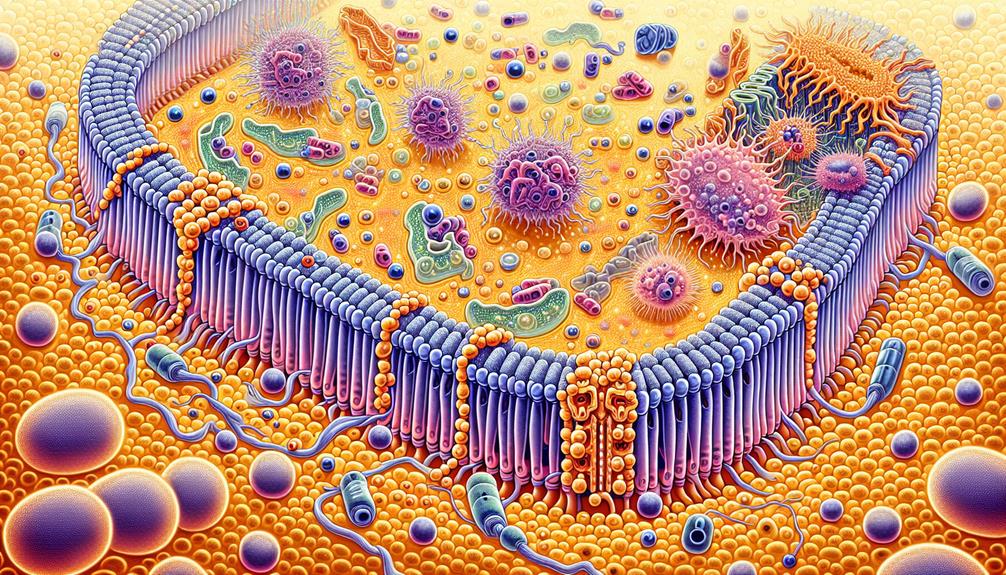Did you know that nearly 30% of a cell's energy expenditure is dedicated to active transport mechanisms? As you explore the complexities of how cells harness ATP to transport substances against their concentration gradients, you'll uncover the pivotal role this process plays in maintaining cellular homeostasis and enabling critical functions. Whether you're a student brushing up on biology or a professional in the healthcare field, understanding these principles is key. Consider the implications for diseases where these mechanisms falter, and think about the potential for innovative treatments. How might enhanced knowledge in this area shape future medical breakthroughs?
Active Transport
You first need to grasp the definition and pivotal role of active transport in cellular processes.
It's essential to differentiate between the primary and secondary types of active transport mechanisms, each employing distinct energy sources and transport proteins.
Definition and Importance of Active Transport
Active transport is essential as it allows cells to move substances against their concentration gradients, using energy typically derived from ATP.
By understanding these mechanisms, you'll see how cells maintain essential functions, such as nutrient uptake and waste removal, despite external fluctuations.
This process is critical for cellular energy balance and signaling, necessitating a detailed analysis of its components and impacts.
Exploring the Cellular Mechanisms
Why do cells invest energy to transport molecules against their concentration gradient?
This active transport process is essential because it allows cells to maintain necessary conditions that passive transport can't achieve.
Types of Active Transport Processes
You'll find that active transport processes are primarily categorized into two types: primary and secondary.
Primary active transport directly utilizes metabolic energy to transport molecules across a membrane against their concentration gradient.
Conversely, secondary active transport involves the use of energy indirectly, harnessing the gradient created by primary active transport to power the movement of other substances.
Primary vs. Secondary Active Transport
When comparing primary versus secondary active transport, it's crucial to distinguish how each process harnesses energy to move substances against their concentration gradients.
Primary active transport directly uses ATP to fuel pumps, pushing ions like Na+ and K+ across membranes.
Secondary active transport, however, exploits the gradient created by primary transport, using it to drive the movement of other molecules indirectly.
Factors Influencing Active Transport
As you explore the intricacies of active transport, it's essential to understand that energy requirements are pivotal.
You'll find that ATP is often utilized to fuel the transport of molecules against their concentration gradients through membrane proteins.
These proteins specifically facilitate the movement, ensuring efficiency and specificity in cellular transport mechanisms.
Energy Requirements in Active Transport
In active transport processes, ATP (adenosine triphosphate) serves as the critical source of energy. This molecule hydrolyzes, releasing energy that directly powers the movement of molecules against their concentration gradients.
Understanding the role and mechanics of ATP in these systems is essential for grasping how substances are transported across cellular membranes.
ATP as the Energy Source
Active transport requires ATP, or adenosine triphosphate, to function as the primary energy source that powers the movement of molecules against their concentration gradients.
You'll find ATP's role vital in maintaining concentration imbalances essential for cellular function.
This energy-rich molecule hydrolyzes, releasing energy indispensable for the active transport mechanisms to propel substances across cellular membranes, despite opposing concentration gradients.
Role of Membrane Proteins in Facilitating Active Transport
Membrane proteins critically govern the efficiency of active transport by selectively facilitating the movement of molecules against their concentration gradients. As you explore further into cellular processes, it's crucial to understand how these proteins operate.
Transport proteins, including pumps and carriers, play a pivotal role. They're not merely passive channels; they actively change shape and affinity to transport substances such as ions, sugars, and amino acids.
Consider the sodium-potassium pump, a classic example of active transport. For every ATP molecule hydrolyzed, three sodium ions are expelled from the cell, and two potassium ions are drawn in. This process is important for maintaining cellular osmolarity and electrical neutrality but depends heavily on the integrity and functionality of the sodium-potassium pump protein structure.
Furthermore, factors like the lipid composition of the membrane itself can affect how these proteins function. The fluidity of the membrane can enhance or inhibit the movement of the membrane proteins, thereby affecting their activity.
You must also note that cellular signaling mechanisms and phosphorylation states can regulate the activity of these transport proteins, adapting to changing cellular needs.
Applications of Active Transport
You'll find that active transport mechanisms are vital in maintaining cellular function by regulating ion concentrations and metabolite levels within cells.
These processes have significant medical implications, particularly as targets for drug development to treat conditions like heart disease and diabetes.
Biological Significance in Cellular Function
You must appreciate how essential active transport is in the transmission of nerve impulses. This process utilizes energy to move ions across neuronal membranes, creating the electrical gradients essential for nerve signal propagation.
Active Transport in Nerve Impulse Transmission
Active transport mechanisms play a crucial role in maintaining ion gradients required for nerve impulse transmission in neurons. Sodium-potassium pumps actively exchange Na+ and K+ ions against their concentration gradients, which is essential for resetting the resting membrane potential.
This precise ion management enables neurons to rapidly fire action potentials, facilitating complex neural communications that are vital for the functioning of the brain and nervous system.
Medical Implications and Drug Targets
Understanding the mechanisms of active transport can greatly enhance the development of targeted medical therapies. Active transport processes are integral for maintaining cellular homeostasis and are exploited in the design of drugs that manipulate these pathways to treat diseases.
For instance, in cancer, some chemotherapeutic agents target the active transporters responsible for cell proliferation and apoptosis. You should note the role of P-glycoprotein, a well-studied active transporter involved in multidrug resistance in cancer cells. This protein actively pumps anticancer drugs out of cells, reducing their efficacy. By inhibiting this transporter, you can increase the intracellular concentration of drugs, thereby enhancing their therapeutic effects.
In the field of neurology, the regulation of neurotransmitters relies heavily on active transport mechanisms. Drugs that modulate the activity of neurotransmitter transporters can alter brain chemistry and are used to treat disorders like depression and epilepsy.
Furthermore, understanding sodium-potassium pumps can help you appreciate their role in cardiac health. Drugs that influence these pumps are used to manage heart rate and force of contraction in conditions like congestive heart failure.
Challenges and Future Directions in Active Transport Research
You'll find that emerging technologies for studying active transport present both novel opportunities and significant obstacles.
As you explore these technologies, consider how precision in measurement and analysis can drastically influence our understanding of molecular mechanisms.
When targeting active transport for therapeutic interventions, it's essential to assess the specificity and efficacy of potential treatments in diverse biological systems.
Emerging Technologies for Studying Active Transport
You'll find that advanced imaging techniques are pivotal in analyzing the mechanisms of active transport at the cellular level. These methods allow for the precise visualization of transport proteins and their interactions within cell membranes, offering insights that are critical for developing targeted therapies.
However, the rapid evolution of these technologies poses significant challenges in standardization and interpretation of data across different platforms.
Advanced Imaging Techniques
Advanced imaging techniques revolutionize how researchers visualize and analyze the mechanisms of active transport at the molecular level.
To deepen your understanding, consider these key tools:
- Super-Resolution Microscopy – Provides clarity beyond conventional limits.
- Single-Molecule Tracking – Offers insights into individual protein dynamics.
- Cryo-Electron Microscopy – Reveals structural details at near-atomic resolution.
- Fluorescence Resonance Energy Transfer (FRET) – Measures molecular interactions in real-time.
Targeting Active Transport for Therapeutic Interventions
Several challenges complicate the targeting of active transport mechanisms for therapeutic interventions, necessitating a detailed understanding of cellular transport processes. You must consider the specificity of transporters, which demands precise drug targeting to avoid unintended effects on similar transport systems in other cells. This specificity isn't just about hitting the right target; it's about ensuring that therapeutic interventions don't disrupt the delicate balance of cellular function elsewhere.
Furthermore, you're dealing with the dynamic nature of cell membranes and transport proteins that adapt to cellular conditions and external stimuli. Developing drugs that can effectively modulate these proteins under varying physiological conditions is a significant task. You have to account for the protein's conformational changes, which can alter drug binding sites and efficacy.
Looking ahead, the integration of computational models and high-throughput screening methods will be essential. These tools can help predict transporter behavior in response to potential therapeutic compounds, streamlining the development process. Additionally, advancements in genomics and proteomics could offer deeper insights into transporter regulation and function, providing new avenues for targeted therapy.
Your ability to navigate these complexities will determine the success of future therapeutic strategies that rely on manipulating active transport mechanisms.



